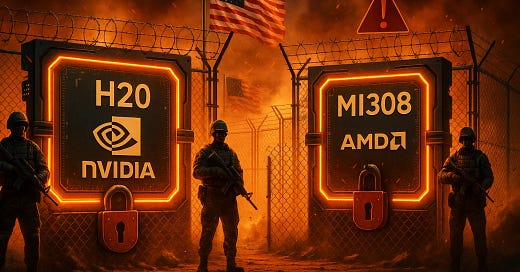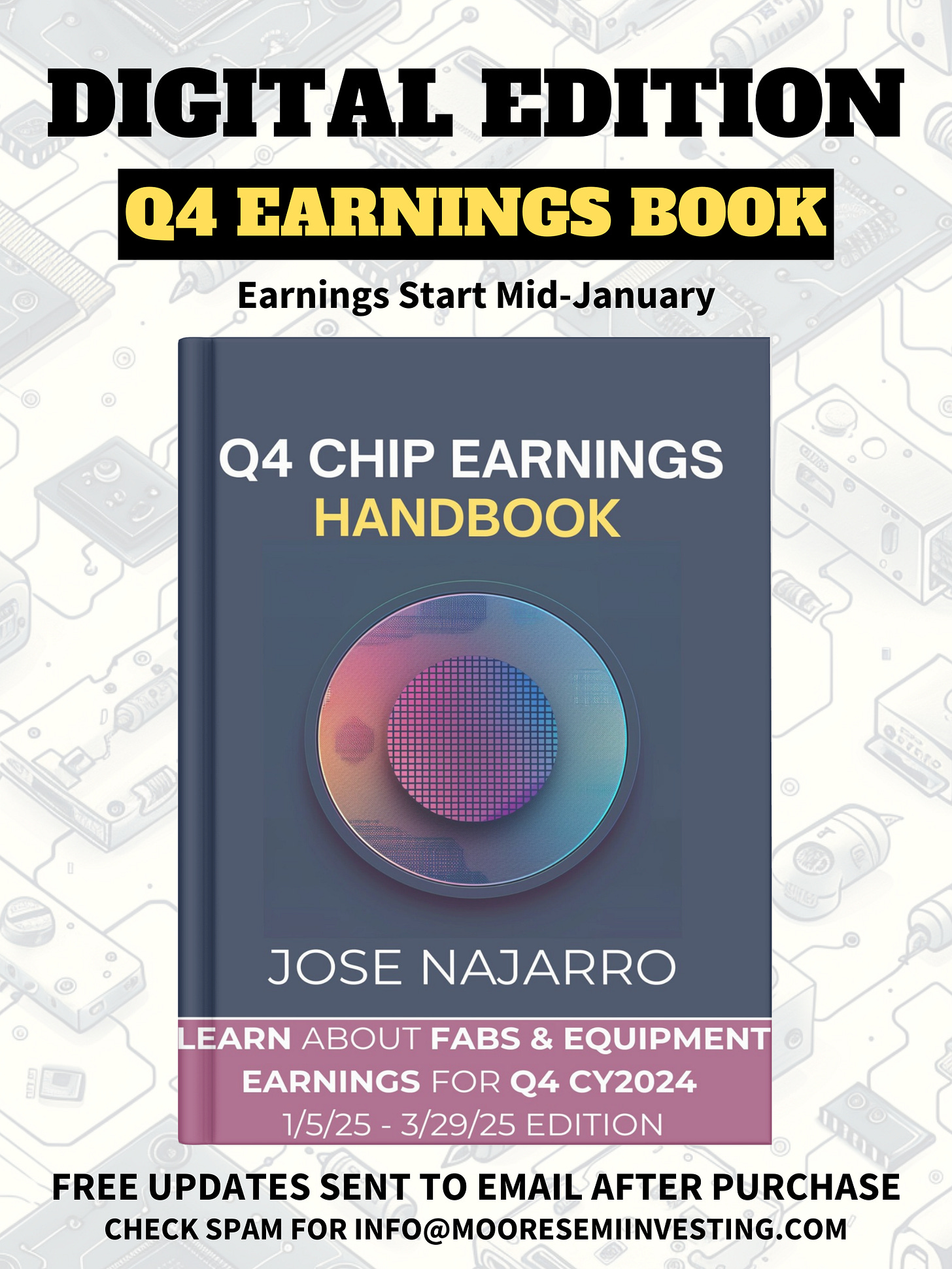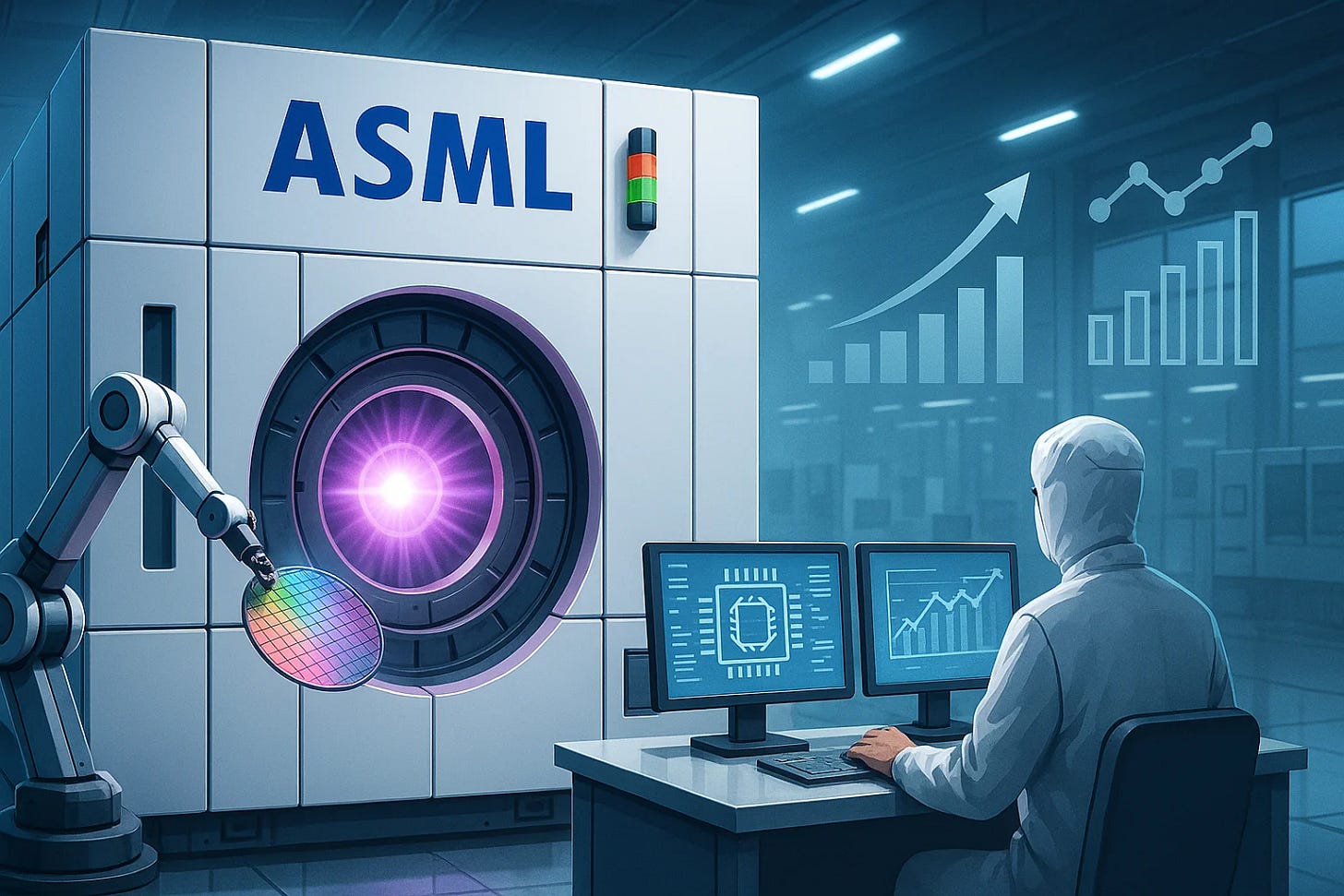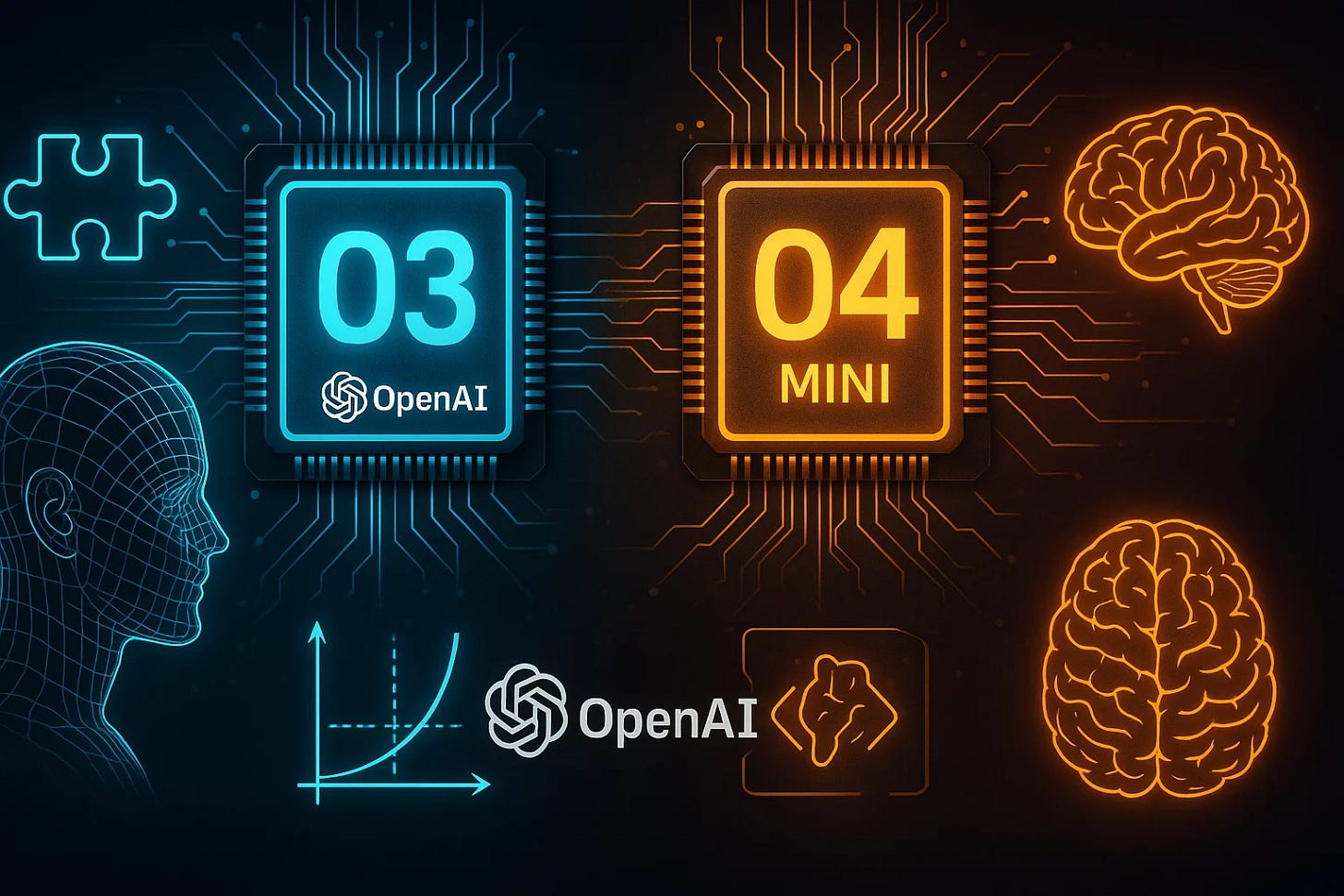🚨 Nvidia and AMD Rocked by Massive US Export Controls!
Welcome, AI & Semiconductor Investors,
Nvidia and AMD face a multibillion-dollar crisis as sweeping US export controls cut deep into their AI chip businesses. Plus, discover how ASML navigates tariff uncertainty with recent earnings results, and explore how OpenAI’s groundbreaking new models are changing the AI game. — Let’s Chip In
What The Chip Happened?
🚨 Nvidia and AMD Rocked by Massive US Export Controls!
🚀 ASML Delivers Strong Q1 Results Amid Tariff Uncertainty
🧠 OpenAI Unveils o3 and o4-mini AI Models: Visual Reasoning Takes Center Stage
[ASML Q1 2025 Earnings: EUV Momentum and Service Expansion Define the Quarter]
Read time: 7 minutes
Nvidia (NASDAQ: NVDA) and AMD (NASDAQ: AMD)
🚨 Nvidia and AMD Rocked by Massive US Export Controls
What The Chip: On April 15, 2025, Nvidia and AMD announced that the U.S. government significantly intensified export restrictions targeting advanced AI chips from Nvidia and AMD, specifically Nvidia's H20 and AMD's MI308, aimed at limiting China's access to cutting-edge semiconductor technology.
The Situation Explained:
💸 Huge Financial Hit for Nvidia: Nvidia announced a staggering $5.5 billion charge in its upcoming quarterly results due to unsellable inventory and supply commitments for its H20 chips previously destined for China.
📉 Stock Shock: Nvidia's shares dropped up to 10% following the news, underscoring investor anxiety about the company’s reliance on China, which represented approximately 13% ($17 billion) of its revenue last fiscal year.
🔻 AMD Also Feeling the Pain: AMD expects an $800 million charge related to inventory and commitments for its MI308 chips. China accounted for over 24% ($6.2 billion) of AMD's revenue in 2024, amplifying its exposure risk.
🎟️ Licensing Uncertainty: Both Nvidia and AMD will seek special export licenses, but historically these approvals have never been granted for high-performance AI chips, creating severe uncertainty about future sales in China.
🌍 Global Market Reaction: The news sparked a broader semiconductor sell-off, affecting Intel, Micron, and Broadcom, as investors brace for further geopolitical fallout.
🇨🇳 China’s Tech Push: China is likely to accelerate its domestic AI chip development efforts, although current alternatives remain significantly behind in performance compared to Nvidia’s and AMD’s offerings.
⚠️ Potential Retaliation Risks: Analysts warn of possible retaliatory moves from China, further escalating the US-China tech and economic tensions.
Why AI/Semiconductor Investors Should Care: This development highlights escalating geopolitical risks in the semiconductor sector. With billions in immediate charges and long-term revenue risks, investors must weigh potential gains from increased US domestic investments against lost opportunities in China—a delicate balancing act shaping the future of the semiconductor and AI landscape.
Moore Semiconductor Investing
📗 [NEW!!] Unlock Q4 Semiconductor Earnings --- 60% OFF (NEW EARNINGS)
What The Chip: Get a front-row seat to the financials shaping the semiconductor industry. This continuously updated e-book by Jose Najarro distills the latest Q4 quarterly insights—from wafer production trends to AI chip breakthroughs—into a single comprehensive resource.
The Situation Explained:
🔵 Dynamic Updates: Start with giants like TSMC and ASML, then expand to 30+ companies as their Q4 2024 earnings roll in. Earnings are restarting!!
🔵 Broad Coverage: From traditional chipmakers to cutting-edge AI semiconductor players, get the full picture as it emerges.
Why AI/Semiconductor Investors Should Care: This evolving earnings handbook gives you a strategic edge. Understanding quarterly earnings data is crucial for gauging industry health, discovering new growth leaders, and aligning your investment approach with emerging technological waves.
Disclaimer: For educational and informational purposes only. Not financial advice. Consult with a qualified professional before making any investment decisions. Updates are only for the Quarter of Earnings.
ASML Holding N.V. (NASDAQ: ASML)
🚀 ASML Delivers Strong Q1 Results Amid Tariff Uncertainty
What The Chip: On April 16, 2025, ASML reported first-quarter financial results, hitting €7.7 billion in net sales and surpassing gross margin expectations at 54%. However, the company highlighted growing uncertainty around potential tariffs and their impact on future quarters.
The Situation Explained:
📈 Sales Strength: Q1 net sales reached €7.7 billion, driven by €3.2 billion in EUV system sales and €2.5 billion from non-EUV systems.
⚙️ Margin Beat: Gross margins of 54% exceeded company guidance due to strong customer productivity milestones and favorable EUV product mix with higher average selling prices (~€227 million per EUV system).
🔄 Order Dynamics: New bookings totaled €3.9 billion, dominated by logic (60%) and memory (40%). China remains a significant customer, now anticipated to be slightly above 25% of annual sales.
📦 High-NA Progress: ASML shipped its fifth High-NA EXE:5000 EUV system in Q1, with production-grade EXE:5200 models set to ship starting Q2, highlighting a robust product pipeline.
🌍 Tariff Turmoil: The recent tariff announcements from the U.S. have created elevated uncertainty. ASML acknowledged potential direct and indirect impacts, including supply-chain disruptions and increased costs, though management is actively working to mitigate these risks.
📊 Q2 Outlook: Projected Q2 sales are between €7.2 billion and €7.7 billion, with gross margin guidance widened (50%-53%) to reflect potential tariff impacts and High-NA system introductions.
💡 Single-Exposure Adoption: Increased maturity and productivity improvements of EUV systems are accelerating the shift from multi-patterning to single-exposure, especially in DRAM applications—a bullish signal for long-term EUV adoption and lithography intensity.
Why AI/Semiconductor Investors Should Care: ASML's results confirm decent industry fundamentals driven by AI and advanced computing demands. However, investors should closely monitor the evolving tariff situation, which could introduce near-term volatility. The accelerated adoption of High-NA and EUV single-exposure technology underscores ASML's central role in enabling cutting-edge semiconductor manufacturing—a key strategic advantage for sustained growth.
OpenAI (Private)
🧠 OpenAI Unveils o3 and o4-mini AI Models: Visual Reasoning Takes Center Stage
What The Chip: On April 16, 2025, OpenAI announced the launch of its newest AI models—o3 and o4-mini—marking a major leap forward in reasoning capabilities, particularly in visual comprehension, coding, and mathematical tasks.
The Situation Explained:
🧠 Enhanced Reasoning: OpenAI's o3 is now its most powerful reasoning model, excelling in math, science, coding, and visual perception. It achieved state-of-the-art results on Codeforces and SWE-bench benchmarks without special scaffolding.
🚀 Efficient Performance: The smaller o4-mini offers robust reasoning at significantly lower computational costs, surpassing previous mini-models in key STEM and data science tasks. Its efficiency allows higher usage limits.
🖼️ Visual Thinking Revolution: Both models can seamlessly integrate visual data into their reasoning processes—transforming how AI handles complex queries involving charts, images, and graphical content.
🔧 Autonomous Tool Utilization: o3 and o4-mini can autonomously leverage all ChatGPT tools, including web browsing, Python coding, and image generation, streamlining user workflows and enhancing autonomous problem-solving.
💡 Reduced Errors and Improved Instructions: External expert evaluations suggest o3 produces 20% fewer major errors on complex real-world tasks compared to previous OpenAI models like o1, highlighting substantial improvements in reliability.
💻 Codex CLI Launch: OpenAI concurrently released Codex CLI, an open-source local coding agent—the company’s first major open-source tool since 2019—backed by a $1 million API credit fund to encourage community innovation.
Why AI/Semiconductor Investors Should Care: OpenAI’s latest advancements reinforce the significance—and costs—of scaling compute infrastructure in AI. As these models redefine state-of-the-art performance, investors must closely watch infrastructure investments, GPU availability, and competitive dynamics shaping the next wave of AI evolution.
Youtube Channel - Jose Najarro Stocks
[NEW] Semiconductor Q4 Earnings Book — 60% OFF
X Account - @_Josenajarro
Disclaimer: This article is intended for educational and informational purposes only and should not be construed as investment advice. Always conduct your own research and consult with a qualified financial advisor before making any investment decisions.
The overview above provides key insights every investor should know, but subscribing to the premium tier unlocks deeper analysis to support your Semiconductor, AI, and Software journey. Behind the paywall, you’ll gain access to in-depth breakdowns of earnings reports, keynotes, and investor conferences across semiconductor, AI, and software companies. With multiple deep dives published weekly, it’s the ultimate resource for staying ahead in the market. Support the newsletter and elevate your investing expertise—subscribe today!
[Paid Subscribers] ASML Q1 2025 Earnings: EUV Momentum and Service Expansion Define the Quarter
Date of Event: April 16, 2025
Executive Summary
*Reminder: We do not talk about valuations, just an analysis of the earnings/conferences
On April 16, 2025, Netherlands-based ASML Holding N.V. (ASML), a leading supplier of lithography systems for the semiconductor industry, reported its financial results for the first quarter of 2025. The numbers highlighted consistent execution and a favorable product mix, particularly within the company’s Extreme Ultraviolet (EUV) portfolio. During the quarter, ASML posted:
Total net sales of €7.7 billion
Gross margin of 54.0%
Net income of €2.4 billion
Quarterly net bookings of €3.9 billion
ASML’s management attributed the company’s performance to a combination of strong EUV system shipments, ongoing installed base service sales, and continued demand tied to artificial intelligence (AI). President and Chief Executive Officer (CEO) Christophe Fouquet remarked, “Our first-quarter total net sales came in at €7.7 billion, in line with our guidance. The gross margin was 54.0%, above guidance, driven by a favorable EUV product mix and the achievement of performance milestones.”
Fouquet also indicated that artificial intelligence remains a central growth driver: “Our conversations so far with customers support our expectation that 2025 and 2026 will be growth years. However, the recent tariff announcements have increased uncertainty in the macro environment and the situation will remain dynamic for a while. As previously shared, artificial intelligence continues to be the primary growth driver in our industry.”
Below is a deeper look at ASML’s first-quarter performance, including growth opportunities, product developments, potential headwinds from tariffs, and the financial deep dive that underpins management’s confidence in ongoing revenue expansion.
Growth Opportunities
1. AI and HPC Demand
ASML reported that artificial intelligence remains a principal catalyst for increased chip complexity and continued lithography intensity. The push toward more advanced computing has driven expansion in High-Performance Computing (HPC) and data center segments. These segments often require the most cutting-edge semiconductor process nodes, leading to elevated demand for ASML’s leading-edge lithography tools.
ASML’s CFO, Roger Dassen, referenced discussions with customers regarding capacity expansions: “If AI demand continues to be strong and customers are successful in bringing on additional capacity to support the demand, there is a potential opportunity towards the upper end of our [2025 revenue] range.”







